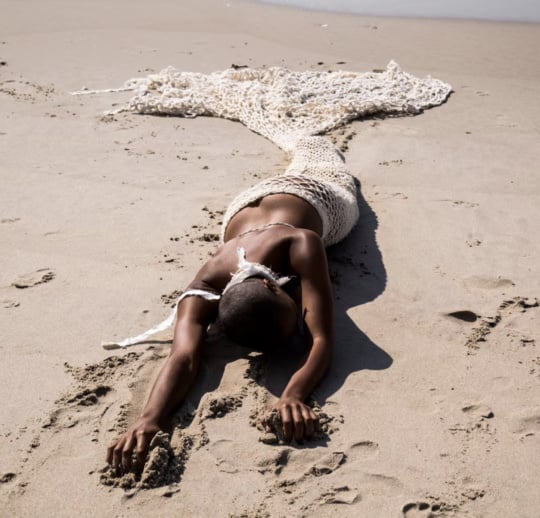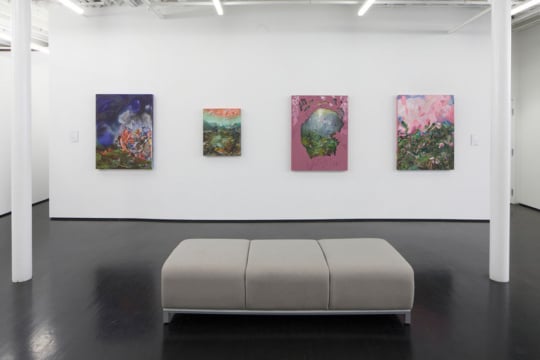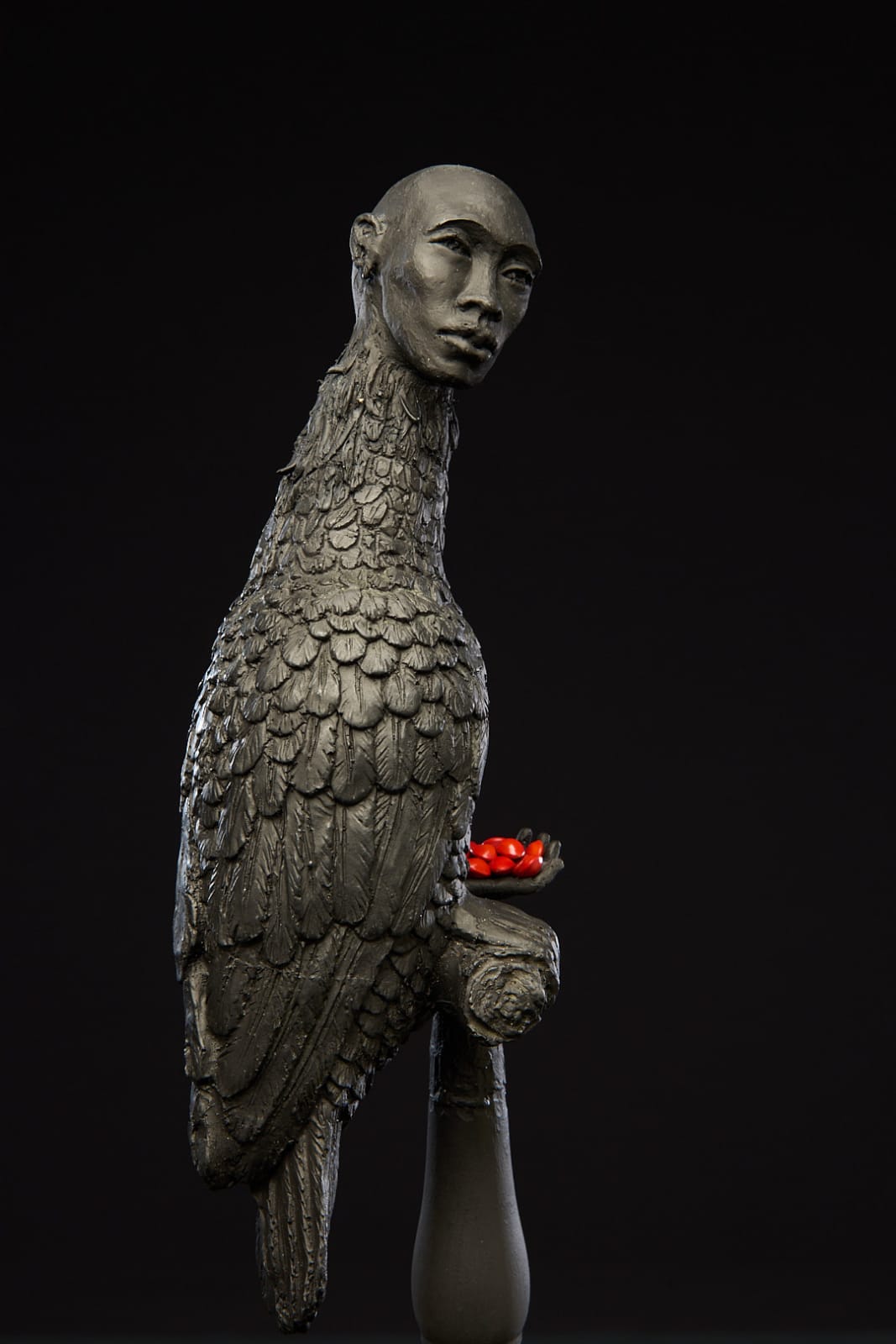
Jasmine Thomas-Girvan weaves together narratives of Afrikan cultural and spiritual retention, colonial resistance, and ecological harmony through a practice deeply rooted in Caribbean historiography. A Jamaican-born artist based in Trinidad, her work, drawing on Maroon heritage, spiritual symbolism, and culturally significant material, is resonant across the Afrikan Diaspora. Over time, her artistic practice has evolved from her training in producing wearable jewellery, as well as textiles, to immersive, room-sized installations. In our interview, she shared the trajectory of her aesthetic journey, where she discussed her technical and thematic evolution as a maker, her time in Maroon Town during a Sustainable Sculpture Residency, and her latest series of work in Fugitive Pathways at New Local Space (NLS) in Kingston.[1]
Thomas-Girvan emphasizes the necessity of pushing beyond conventional limitations within her work, stating, “A very important thing to recognise is that we are locked in a matrix. From the moment we are born, we are taught a specific set of social norms—what is acceptable, what is good, what is bad.” Adding that, “if you really want to reach beyond those limitations, then you have to step into a zone of the unknown. And so, you have to be open to failure. The outcome is not guaranteed.” For Thomas Girvan, “that is a very important part of the quest—it is the journey, not the destination, that matters most.”[2]

This embrace of the unknown and unfamiliar defines Thomas-Girvans’ approach to materiality. She engages intuitively with her surroundings, drawing on her fine arts training in jewellery and textile design at Parsons School of Design to integrate natural materials from Caribbean landscapes into multidisciplinary works that engage historical narratives of Afrikan diasporic existence. Guided by each material’s intrinsic qualities, she adapts her approach accordingly, sparking further experimentation and incorporating new elements. By juxtaposing the highly valued with discarded materials, she draws audiences in with the alluring glint of precious metals while simultaneously challenging them to reconsider colonial value hierarchies and reimagine the significance of the overlooked.
The work in Fugitive Pathways epitomizes her artistic evolution from jewellery-making to encompass sculpture, glassblowing, papermaking, assemblage, video, and installation techniques. This new series comprises eighteen pieces that meticulously merge traditional “high-value” materials (bronze, sterling silver, steel, mother-of-pearl, and glass) with found objects from Maroon Town (burnt bamboo, calabash, Cawcoon seeds, cow horns, and snail shells). These works symbiotically blend the organic and inorganic, the treasured and the discarded, into a non-hierarchical system that emphasizes transformation and ecological harmony. By contesting western eurocentric notions of value and aesthetics entrenched within the postcolonial Caribbean while elevating the significance of Afrikan traditions, Thomas-Girvan’s practice can be understood as an act of decolonial praxis.
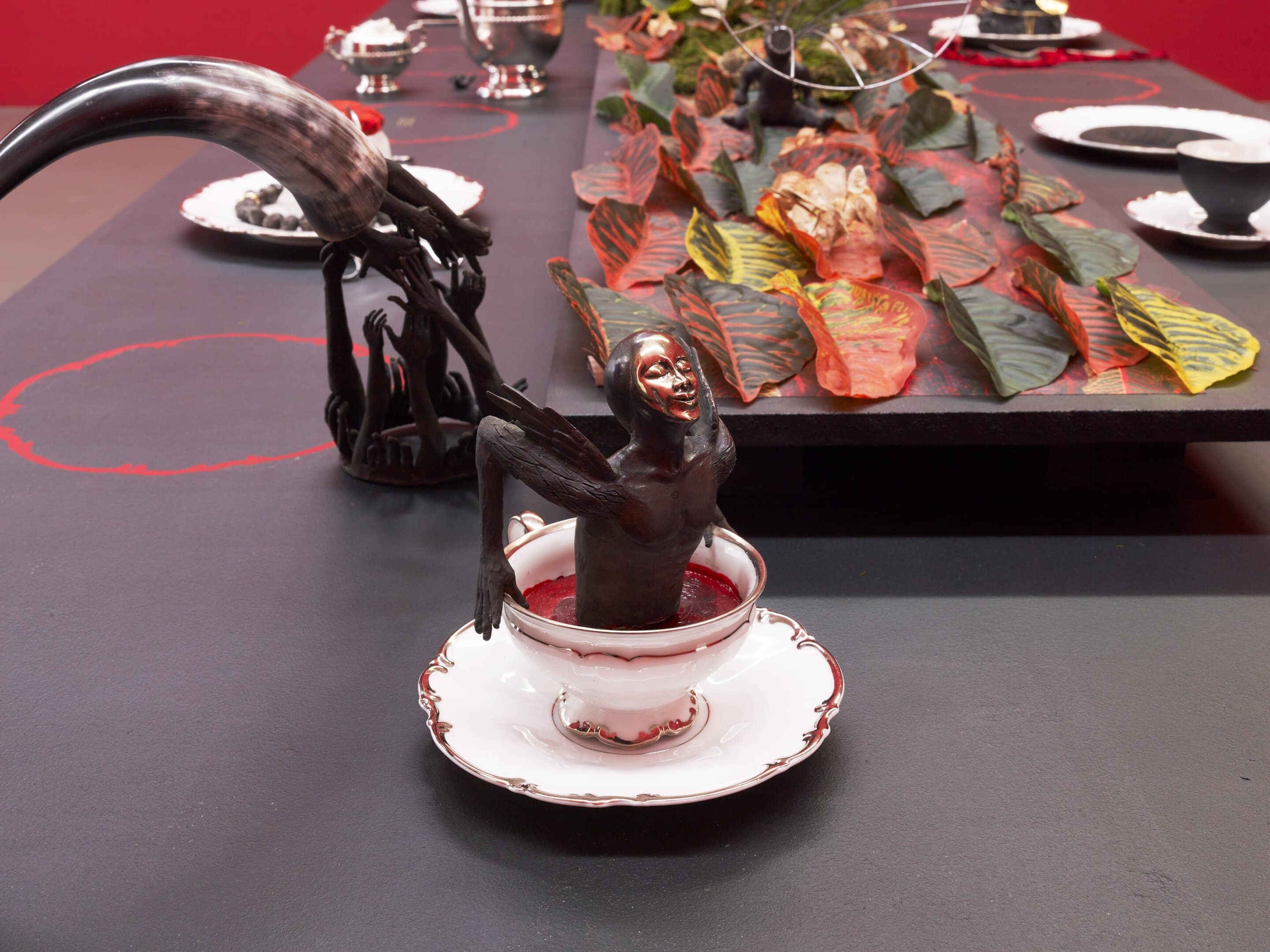
Thomas-Girvan encapsulates her distinctive practice with the Jamaican adage, “Yuh affi tun yuh han mek fashan!”—a testament to resourcefulness and adaptability in the face of adversity. This ethos is evident in earlier works like Parallel Realities, Dwelling in the Heartland of My People (2016) and The Real Princess (2016), both exhibited at the Jamaica Biennial in 2017.[3] In Parallel Realities (2016), she integrates materials traditionally used in Revival rituals and rites, such as red and white candles and croton leaves, with western colonially-valued objects like glass sculptures and fine china. These elements are meticulously arranged on an elaborately set table reminiscent of the Feasting/Thanksgiving Tables used in Revivalist ceremonies, which serve as offerings to both ancestral and deific spirits.[4]
Through her deliberate material choices, Thomas-Girvan’s artworks embody the essence of ritualistic objects, highlighting the enduring institution of Afrikan-Caribbean spirituality, which has expressed itself in various forms, including Revival (Myaal) in Jamaica and Orisha (Shango) in Trinidad and Tobago.[5]. Central to her practice are ideas rooted in marronage, which historian Marcus Nevius defines as the efforts of enslaved “fugitive” Afrikans and their descendants to escape enslavement and reject colonialism.[6] Marronage extends beyond physical resistance to encompass cultural defiance, particularly through the preservation and transformation of Afrikan traditions that challenge colonial systems.
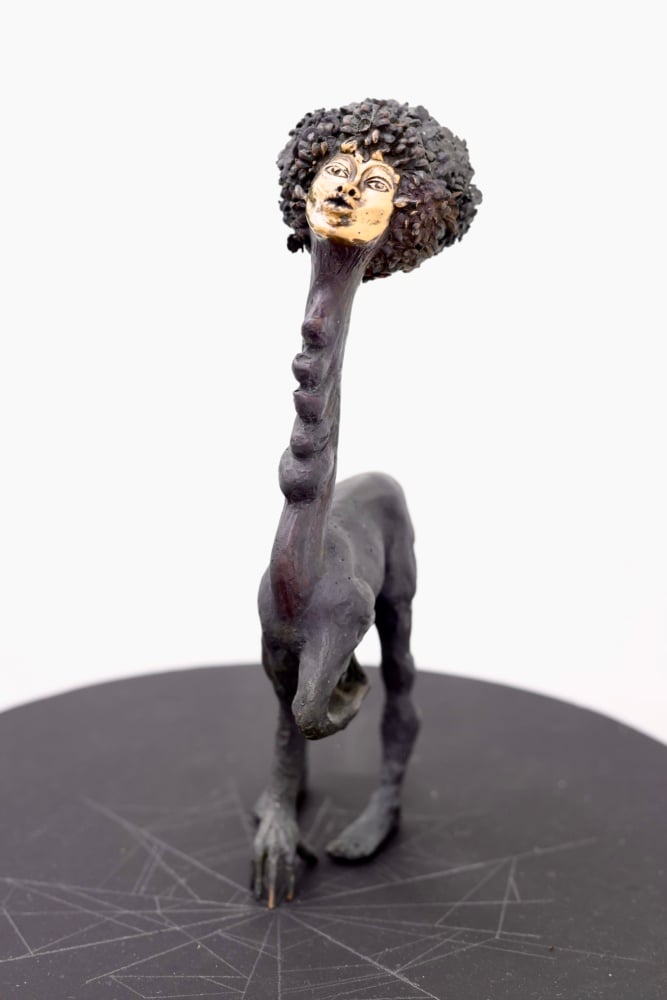
Through this lens, her work becomes both an assertion of identity and an act of resistance, reaffirming the persistence of Afrikan-derived spiritual and cultural practices in contemporary Caribbean life.
There is a Meeting Here Tonight (2024) stands as a thematic and technical cornerstone within her practice. This shadow box, one of seven, functions as an intricately crafted, minute theatrical space, inhabited by mystical chimeras, including one of her signature anthropomorphic birds, previously seen in Anansi (2009) and None but Ourselves (2015). Set in a dense, silhouetted jungle, the figures gather around a spider’s web, a sacred emblem woven by Griot Anansi, who sits alongside the Empress of Jamaica, invoking the spirits of the Ancestors.[7] Thomas-Girvan’s recurring allusions to Anansi highlight her celebration of the resilience of Afrikan cultural, spiritual, and mythological traditions in shaping diasporic culture.
The title, drawn from an African-American (“Negro”) spiritual song used as a coded message by enslaved Afrikans, reinforces themes of secrecy, resistance, and survival associated with marronage. The work’s references to Maroon histories, subterfuge, and spiritual interconnectedness reflect the enduring strategies of Maroon communities and freed peoples across the Caribbean, Latin America, and the Southern United States.[8] Much like the hymn that it employs in its title, There is a Meeting Here Tonight embodies the convergence of Afrikan spirituality, cultural retention, and resistance into a cohesive system of survival. The lyrics themselves are an invitation to commune, underpinning the importance of unity and solidarity to survival:
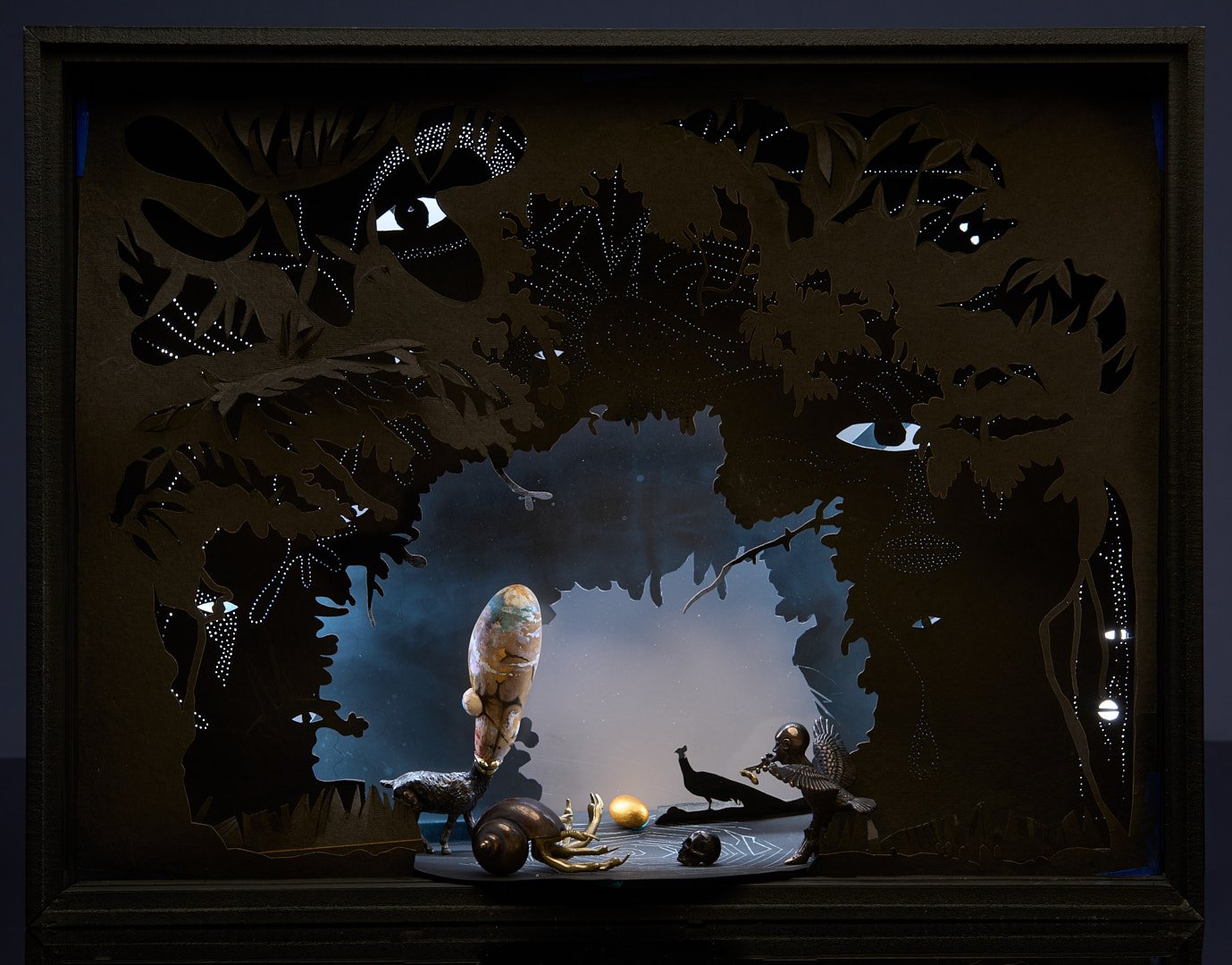
“Get you ready, there’s a meeting here tonight,
Come along, there’s a meeting here tonight;
I know you by your daily walk.
There’s a meeting here tonight.”
—There’s a Meeting Here Tonight, Cleveland and Nix (1981).[9]
Jasmine Thomas-Girvan’s engagement with colonial resistance and spiritual interconnectedness in the Caribbean is crucial as it directly challenges Eurocentric material hierarchies and reimagines the significance of both cherished and discarded objects. Drawing on Afrikan diasporic legacies, particularly Maroon heritage, marronage, and Revivalist practices, she recontextualizes these traditions within contemporary art, emphasizing their relevance in the postcolonial Caribbean. By merging traditionally and colonially-coded high-value materials with found objects from Maroon Town, she produces work that reclaims the ancient wisdoms of Jamaican Ancestors who have survived by hiding in plain sight. In this way, Thomas-Girvan’s practice is an act of decolonial praxis that decentres colonial axiologies within the fine arts while elevating Afrikan traditions. Her work reaffirms the resilience of Afrikan spirituality and cultural practices in the contemporary, while honouring the ongoing struggle for identity, autonomy, and survival within the Diaspora.
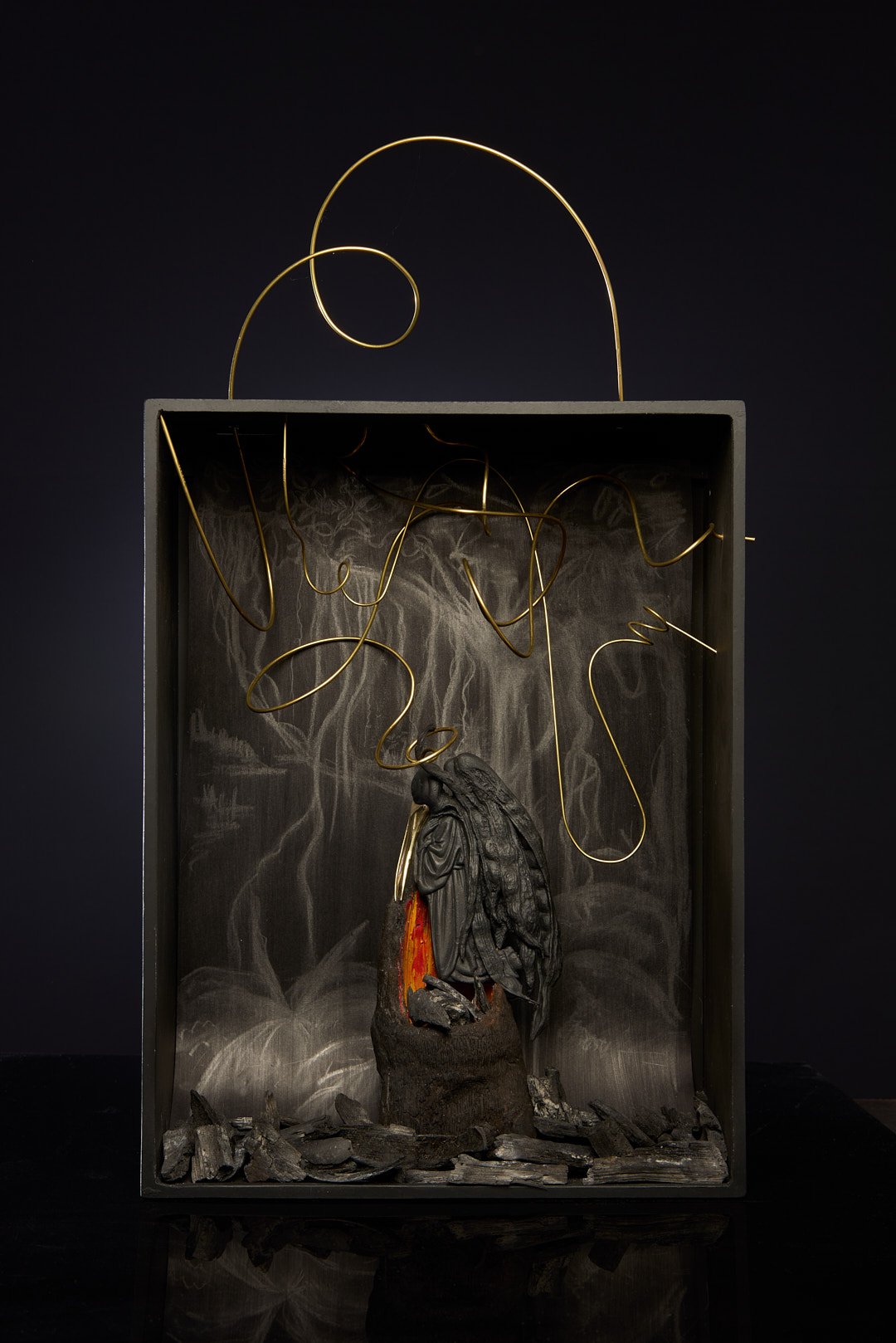
[1] Thomas-Girvan, Jasmine. Interview by the author. New Local Space, Kingston, January 12, 2025.
[2] Ibid.
[3] National Gallery of Jamaica. “Jamaica Biennial 2017 – Invited Artists: Jasmine Thomas-Girvan.” 2017. https://nationalgalleryofjamaica.wordpress.com/tag/jasmine-thomas-girvan/
[4] Hutton, Clinton. “The Revival Table: Feasting With the Ancestors and Spirits,” Jamaica Journal 32, no. 1–2 (2009): 18–32.
[5] Hutton, Clinton. “African-Caribbean Spirituality and Creativity.” Caribbean Quarterly 65, no. 2 (Special Issue June) (2019): 207–11.
[6] Nevius, Marcus P. “New Histories of Marronage in the Anglo-Atlantic World and Early North America.” History Compass (2020). https://democracy.missouri.edu/wp-content/uploads/2023/06/2023-SOF-Conference-Nevius-Reading-2.pdf
[7] McKenzie, Zakiya. Testimonies on The History of Jamaica Vol.1. United Kingdom: Rough Trade Books and Garden Museum. 2021.
[8] Cleveland, J. Jefferson, and Verolga Nix. “There’s a Meeting Here Tonight.” Hymn in Songs of Zion, p.128. Nashville: Abingdon. 1981.
[9] Ibid.


